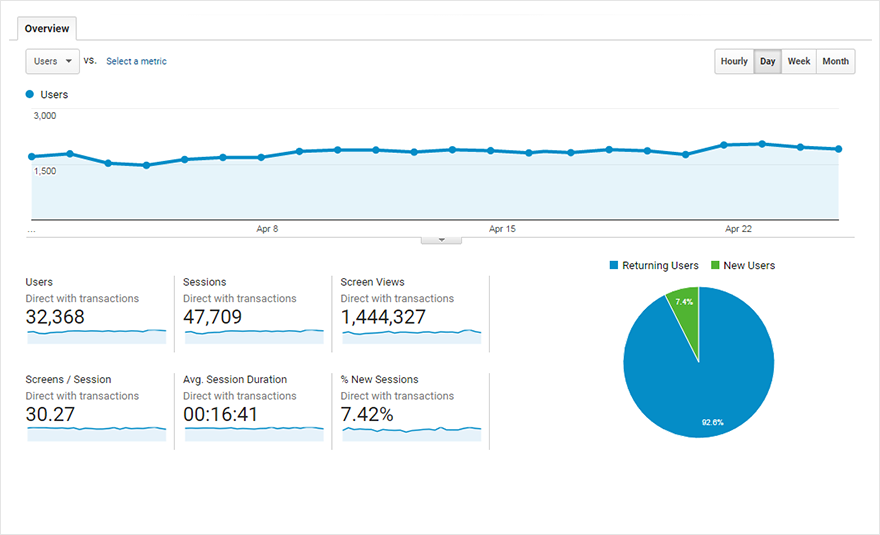

- #GOOGLE ANALYTICS MOBILE SESSION DEFINITION HOW TO#
- #GOOGLE ANALYTICS MOBILE SESSION DEFINITION ANDROID#
- #GOOGLE ANALYTICS MOBILE SESSION DEFINITION SOFTWARE#
- #GOOGLE ANALYTICS MOBILE SESSION DEFINITION FREE#
Notice that when you select Devices from the Mobile drop down, Google Analytics groups mobile devices and tablets together in one aggregated group. Not only will we see the qualitative usage of each device, but we can also pinpoint certain devices that frequently present bugs in our application.Īlright, almost 50% of our mobile users are coming via Apple Devices. We can dive in deeper to each segment to see which devices we should be testing more frequently. The usage stats for this particular account moderately favor mobile devices, which is great. In this example, about 15 percent of our traffic is from a mobile device or tablet. On the overview page, you should see all your normal Google Analytics data segmented between Desktops, Mobile and Tablets. To see what percentage of your users are on mobile devices open up the Audience tab, and select Mobile and Overview.
#GOOGLE ANALYTICS MOBILE SESSION DEFINITION FREE#
Google Analytics can be a quick and free way to measure screen resolutions, devices, and the browsers your site’s visitors are often using. At CrossBrowserTesting we are obviously a little obsessed with what devices and screens our customers are using (we have over 1500 different browsers), so we use Google Analytics to measure this metric.
#GOOGLE ANALYTICS MOBILE SESSION DEFINITION SOFTWARE#
Displaying a consistent experience across platforms and devices is integral to web and software development in today's market.
#GOOGLE ANALYTICS MOBILE SESSION DEFINITION ANDROID#
Testing on every single device can be a challenge, given the fact Android alone has over 25,000 different device combinations across 10 operating systems. Session Length from last year/month compared to this year/month).Diving into what browsers and devices your website is accessed from can help you concentrate your testing on the devices and browsers that your customers are actually using. It’s helpful to compare your current Session Length with both industry benchmarks for your type of app and historical trends for your app (i.e. It’s important to track Session Length against the objectives for your specific app. Gaming, media and entertainment apps tend to engage users for longer while social networking and ecommerce apps fall on the shorter spectrum of Session Length.


Of course, this varies notably based on app type. On average, mobile users will spend approximately five minutes in an app. Understanding the objective your app and the expected user behavior is critical for effectively tracking and improving Session Length. An example of this might be a security app like Google Authenticator (only need it long enough to get the code) or 1Password or perhaps even a service app like Uber or Lyft where the longer someone is in the app the more likely they are to be frustrated (i.e. Cons:įor some apps, increasing Session Length may not be the objective which means this metric is less helpful as a measure of engagement. complete a purchase, connect with more people, share content, spend an increasing amount of time, achieve a new level, or unlock add-ons or special features).įor example, if you have a commerce app and the checkout process takes four minutes, you need to make sure people are staying in the app for at least four minutes or shorten the checkout process. Depending on the purpose of your app, you can determine if users are staying in the app long enough to complete desired actions (e.g. Session length is a critical mobile app metric because it provides the baseline for user engagement. Tools like Mixpanel or Google Analytics make it easy to customize and track exactly what you determine to be Session Length for your app. Of course this should be customized to fit your app type and objectives. The most basic calculation for Session Length is the time the app was launched subtracted from the time the user becomes inactive (or leaves the app). Time user becomes inactive - time app was launched = (#) Session Length
#GOOGLE ANALYTICS MOBILE SESSION DEFINITION HOW TO#
Session length is not the only metric for measuring engagement, but it is one that really matters.” - Henry Cipolla, CTO of Localytics How to calculate Session Length “It is important for app publishers to understand whether their app’s mission is best served by keeping users in the app as long as possible or by returning them as quickly as possible, and only session length can tell them that. a streaming app may timeout after a certain duration or track time running in the background). Depending on the type of app, Session Length can be defined more narrowly as needed (e.g. It tracks the duration of an individual, continuous experience in the app.

The Session Length of an app is the amount of time from when a user launches the app until they stop using or leave the app.


 0 kommentar(er)
0 kommentar(er)
